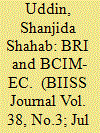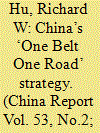| Srl | Item |
| 1 |
ID:
161952


|
|
|
|
|
| Summary/Abstract |
The Belt and Road Initiative (BRI) is one of the largest development plans
initiated by China which includes 65 countries covering Asia, Africa and Europe.
While Bangladesh-China-India-Myanmar Economic Corridor (BCIM-EC) is a subregional cooperation that aims to introduce new impetus to economic and social
development by linking the southwestern parts of China with northeastern
region of India and the Bay of Bengal through Yangon and Mandalay in
Myanmar, and Bangladesh. Although BCIM-EC was initiated long before the
inception of BRI, China later incorporated it under BRI platform as one of the six
economic corridors. Instead of analysing why BCIM-EC was incorporated within
BRI, the paper attempts to focus on the impediments that BRI and BCIM-EC are
facing during implementation phase. Therefore, the paper limits its scope to
examine the impediments and investigate how China as a pioneer of BRI along
with member countries of both BRI and BCIM-EC can overcome these emerging
challenges. The paper attempts to formulate policy suggestions recommending
strategies for China to overcome these impediments with the assistance and
support of all the member countries of BRI and BCIM-EC.
|
|
|
|
|
|
|
|
|
|
|
|
|
|
|
|
| 2 |
ID:
153114


|
|
|
|
|
| Summary/Abstract |
This article examines One Belt One Road (OBOR) strategic implications for India. It is argued that the
implications need to be considered within the framework of the future development of the China–India
relationship. The relationship is largely constrained by and embedded in the security dilemma at the
present time. Taking the opportunity offered by the OBOR initiative, China and India should explore
building a ‘new model of major power relationship’ between the two countries. While the border issue
and regional security rivalry may not find an easy way out, it should not impede the leaders of the two
countries from expanding the areas of cooperation and building up strategic trust between the two peoples.
Beijing and New Delhi can and should find more areas of cooperation on non-traditional security issues,
such as food security, water, energy, strategic metals, common concern over environmental protection and
climate change and reforming the post-war international economic order.
|
|
|
|
|
|
|
|
|
|
|
|
|
|
|
|